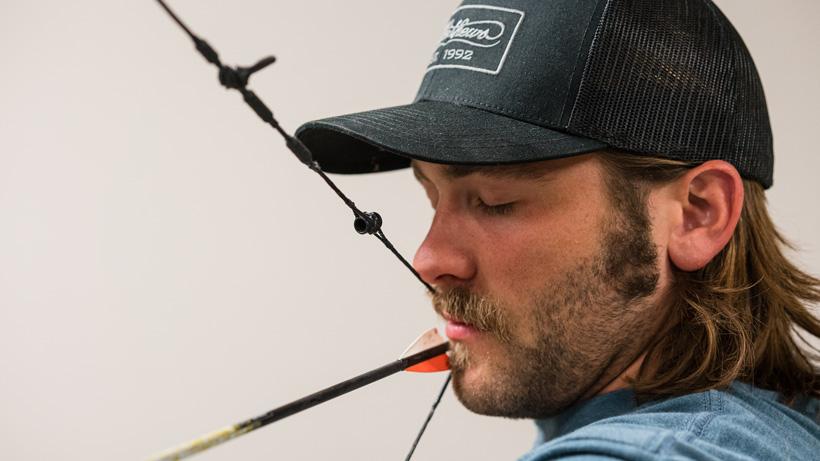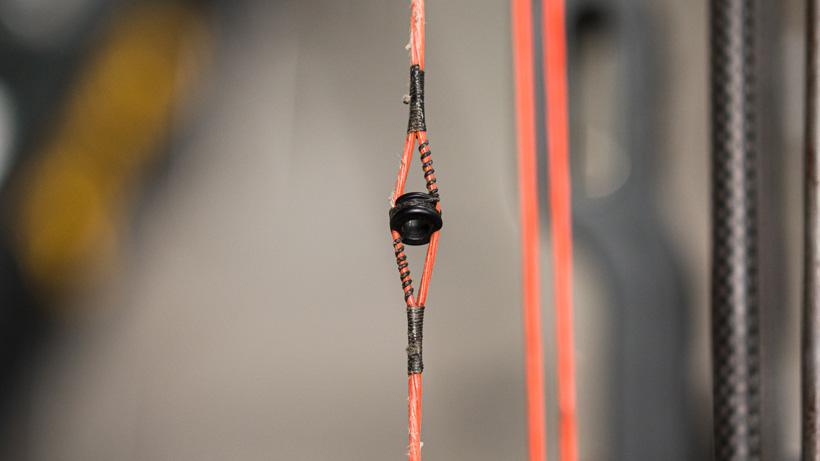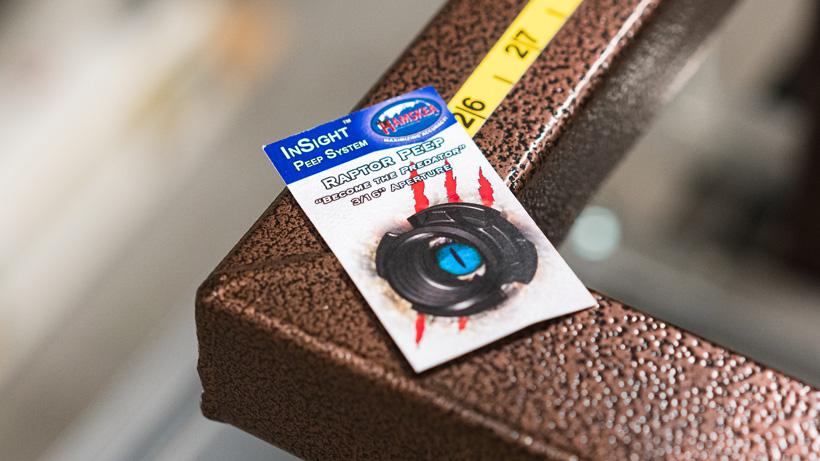




Checking peep height at full draw.



Adjustments can be made on dovetail sights to help match your peep sight to your bowsight housing.

When purchasing a new bow setup, perhaps the most impactful yet cheapest piece of gear you will buy will be your peep sight. Most of these can generally be had for under $10, but they can make a huge impact on your shooting accuracy, consistency, and effectiveness. On the other hand, a poorly adjusted or incorrect peep size can drastically hurt your shooting efforts as well.
Determining which peep style and size is correct for your bow can take some trial and error, but can be done fairly easily when following the correct steps.
While working in various archery shops, it was not an uncommon occurrence for a confused archer to wander into the shop wondering why their bow can be tuned properly, but their groups were all over the place. While the likely culprit could be a plethora of things, the most common issue was peep placement or, rather, an incorrect placement of the peep.
Peep sights really need to be placed in the most natural position for the archer as possible. That is to say: at full draw, a shooter should not be looking for the peep and should instead naturally anchor into the peep. A peep that is placed too high on the string can cause a floating anchor and will inevitably lead to unexplainable and bizarre groupings. On the other hand, a peep that is placed too low on the string will cause the shooter to compress and contort their form leading to a lot of undue torque on the bow and, eventually, poor accuracy.
A simple test can be performed at home to ensure your peep is in the correct place. Nock an arrow and draw your bow in a safe direction. Once at full draw, close your eyes and comfortably settle into your anchor point. Once everything is set and comfortable open your eyes and observe where your peep is sitting. Too high? Too Low? If the peep is anywhere other than directly centered over your sight housing then it needs to be adjusted. Keep in mind that any peep movement will cause a point-of-interest change, but generally will not affect the pin gap.
A perfectly placed peep will almost disappear at full draw. At full draw, you should be seeing nothing but your pin(s).
Be sure to check out the video below to watch Trail Kreitzer walk through how he installs a peep sight:
When walking into your local shop, the most commonly encountered peep sight sizes will be 1/8”, 3/16” and 1/4”. These three sizes will cover 95% of the shooters out there; however, it may be necessary to look into some of the in-between sizes in extreme cases like 1/16", 3/32", 5/32" or even 7/32". Out of the most common three sizes, 3/16” peeps are by far the most common and will fit most sight styles.
The general rule of thumb is that a smaller peep diameter provides more accuracy, while a larger peep size provides better low-light performance.
I spent some time researching peeps and ended up selecting the Hamskea Raptor Peep.
Generally speaking, there are two types of peep sights for archers to consider: tube peeps and tubeless peeps (free float). A tubed peep will use a small rubber hose attachment that connects the peep to one of the bow’s cables. When drawn, the rubber tubing will become taut and will pull the peep in a straight line, aligning it perfectly. A tubeless peep is just as it sounds: a peep with no tubing that is simply tied free-floating to the string.
The choice between the two styles will really boil down to the current quality of strings installed on your bow. Don't forget that we sell bow strings at the GOHUNT Gear Shop. A low-quality string will stretch and spin as the bow is drawn and shot—a job best suited for a tubed peep. On the other hand, tubing for these peeps can become dry-rotted and break over a short period of time, and can become an overall nuisance. Silicone tubing will generally last much longer than traditional latex tubing. When making this decision, it is best to seek out the advice from a trusted shop or from your bow's manufacturer.
There are generally two accepted ways of using a peep sight: either centered on your sight housing or centered on the pin you are currently using.
Centering on the sight housing is the most commonly used method and my recommended method, but it is all about experimentation with your setup and your shooting style. Generally speaking, those who are centering on an individual pin can get away with smaller peep sizes.
When initially selecting a peep size, I like to first look at my sight housing. Sight housings under 1.75” diameter will usually perform great with a 3/16” peep or smaller, while sights with a 2” or bigger housing will generally benefit more from a 1/4” peep. Once a starting peep has been selected, archers will have a few more adjustment options for an optimal relationship between their sight and peep.
Dovetail sights, which are becoming more and more common in the hunting world, allow for a wide range of adjustments as the sight can be slid away or toward the bow. If the peep is larger than the housing, try sliding the sight closer to the riser. If the peep is smaller than the housing, try moving the housing further away. Additionally, many sights with traditional mounting brackets will now sport several sets of mounting holes, allowing for some slight adjustments.
With 30” axle length bows becoming the norm, string angle is also now becoming an important factor to consider when selecting a peep, particularly those with longer draw lengths. As the axle length on a bow is decreased, the string angle becomes greater and greater, inevitably moving the peep further away from the archer’s face. As the draw length is increased on a bow, the string angle will also become steeper and steeper. In other words, on the same bow, an archer with a 27” draw will be much closer to the peep than an archer with a 31” draw.
As the peep moves away from the archer, a bigger peep may be needed than what is normally accepted. Conversely, on a longer axle length bow or for those with shorter draw lengths, a smaller peep may work.
As mentioned before, the general rule of thumb for peep selection is that a smaller diameter will lead to better accuracy, while a larger peep will lend itself to better low-light performance. The golden goose in this equation is finding out what combination of these factors works the best with your setup and then balancing that against your typical hunting environment. With five minutes of light left, a 50-yard shot on the prairie can look a whole lot different than one in the forests of northern Idaho. I generally prefer to lean more toward the large size for a hunting setup, but at my short draw length of 27.5”, anything over 3/16” is generally getting a little too big.
Once again, verifying that your peep and sight are correctly set for your bow is very easy to do at home. Simply head out to your target (a solid colored background can help immensely), come to full draw, and concentrate on how the sight housing looks in relation to the peep. If there is too much daylight around the sight, try moving the sight closer to the riser if possible; if the peep is smaller than the sight housing, you can also try to move the sight further away from the bow.
If you learn anything from this article, I hope it is that there is no single right way to go about peep size selection, and experimentation is key. Through many years of experience, I can generally guess an archer into the ballpark for peep size, but almost always, there will need to be additional steps taken to ensure a perfect relationship between all of the cogs on the wheel. A 1/8” peep and its accuracy may be attractive on the range, but its low light performance may cost you a shot. On the other hand, the low light performance of a 1/4” peep might be great, but, if your sight housing is swimming at full draw, your accuracy and consistency will suffer.
This article was originally published on August 26, 2019, and has been updated with more information.